The 2015 MacBook Review
by Ryan Smith on April 14, 2015 10:15 AM ESTWindows Performance
Shifting gears from OS X, let’s take a look at performance under Windows. Though not every MacBook will be used with Windows, Windows gives us a wider selection of benchmarks to work with, and it gives us a chance to compare the MacBook to some contemporary PCs.
For our Windows comparison I’ve pulled in a number of results from our most recent Core M review, including other Core M laptops, the Haswell-U powered Surface Pro 3, and a couple of Broadwell-U powered laptops. Of particular interest is likely the Asus UX305, which is another Core M based laptop that uses a very similar build. At 13.3” it’s larger than the MacBook, but it is a similar aluminum fanless design.


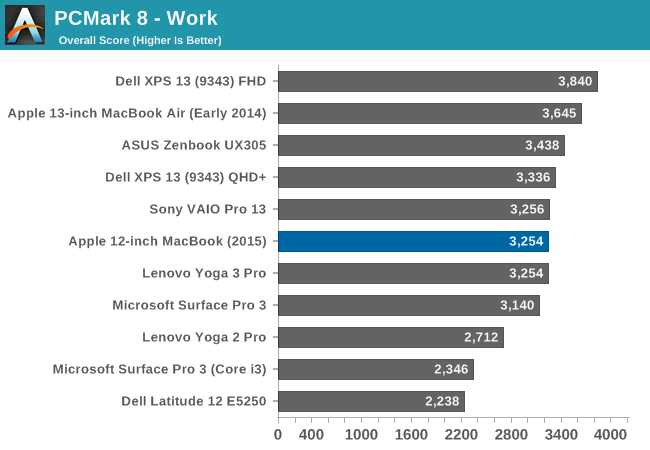
Depending on which sub-test we’re looking at, the PCMark workloads are a mix of bursty workloads, lightly threaded workloads, and heavily threaded workloads. As a result the MacBook and its Core M processor are given some opportunity to show off, and at other times is pushed back due to its cap on sustained performance.
The Home workload is one such light test, which plays into the MacBook’s favor. Here it’s towards the top of the charts, surpassing everything other than the Core M based Asus UX305, and then the more powerful Broadwell-U based Dell XPS 13s. I keep rattling on about workload types and this is a good example of why it matters, because in a light workload the MacBook is among the fastest of the ultra-portables, beating out many other Core M devices and also some Haswell based Ultrabooks. Put another way, in a light workload Core M can already deliver (and at times exceed) one-generation old Haswell Ultrabooks.
As for the Creative and Work workloads, the MacBook still places relatively well. Doing this well on the Creative workload was a bit of a surprise, since it’s the most demanding benchmark of the 3. I suspect we may be seeing a mix of dividends from the SSD and Core M’s GPU, Otherwise the lighter Work test actually has the MacBook farther behind the pack, with performance in-line with other Core M laptops, though not as exciting compared to the Ultrabooks.
Overall, between our OS X and Windows CPU benchmarks, what we’re finding is that the performance of the MacBook generally mirrors our expectations given what we know about its design and component selection. Given a light workload that allows the Core M CPU inside of the MacBook to turbo to its fastest speeds, it’s a very potent competitor in a small package, able to give all but the most recent Ultrabooks a run for their money. However heavier, sustained workloads drive a wider gap in between the two classes of devices, and in those cases the MacBook offers performance closer to Ultrabooks a 3-4 years old.
Shifting gears one more time, let’s take a look at GPU performance. GPU workloads present an interesting scenario for Core M, and by extension the MacBook. The underlying Intel HD Graphics 5300 GPU is a GT2 configuration, making it moderately powerful for an iGPU, however the power and thermal constrains on the MacBook means that the laptop doesn’t have the power required to run a GT2 GPU at full speed.
With the Broadwell CPU cores alone able to chew up 4.5W and then-some, a combined GPU+CPU workload will generally put the MacBook in a pinch. Consequently I don’t see the MacBook being used as any kind of gaming machine – the MacBook Air is undoubtedly a much stronger contender – but it’s useful to put this performance in context.
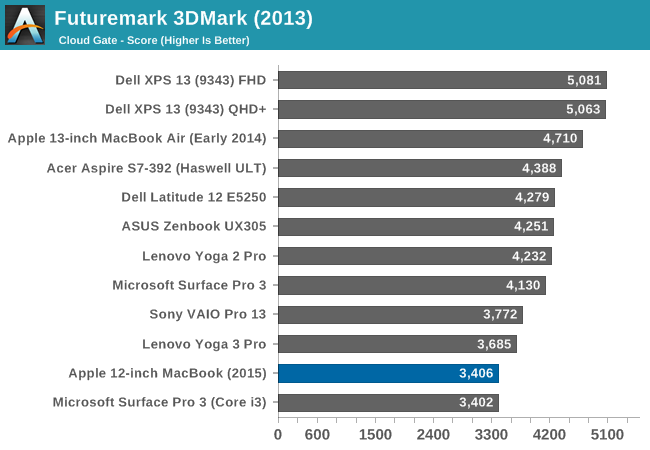
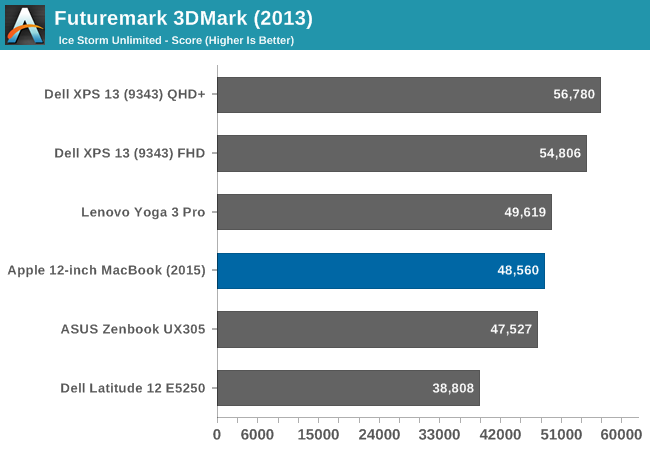
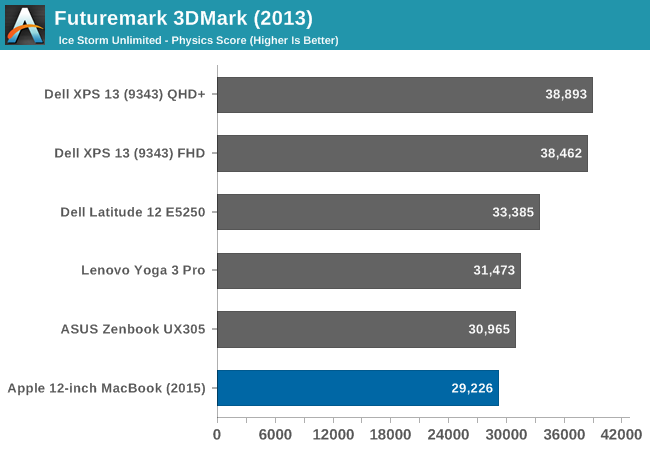
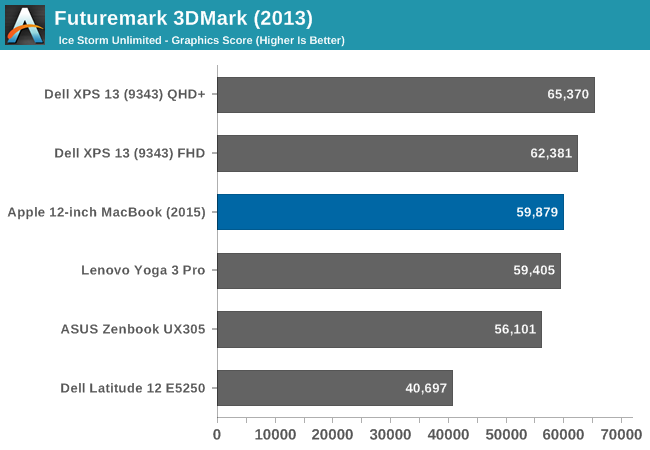
Our 3DMark scores handily illustrate this exact point. Facing significant power and thermal limits, the MacBook has to pull back in performance and consequently ends up near the bottom of our charts, versus its much better showing in PCMark. The 2014 MacBook Air 13” is some 38% faster at Cloud Gate, and on the newer Ice Storm benchmark the results aren’t much better. Of the two it’s worth noting that Cloud Gate is a much more complex and longer running benchmark, whereas Ice Storm is a quick running tablet-sized benchmark. Consequently Cloud Gate throttles harder and sooner, which is why the MacBook does relatively worse there. Overall the MacBook doesn’t even beat any of the other Core M laptops, which is a bit surprising. But nothing here is quite like the MacBook, so it’s somewhat different in its combination of small size and aluminum chassis.
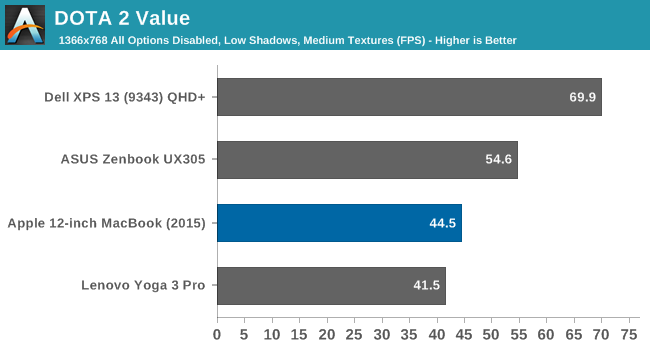
Meanwhile I have also run our DOTA 2 Value benchmark against our other Core M devices and the Broadwell-U based Dell XPS 13 for good measure. On an absolute basis 44.5fps is definitely playable for a game like DOTA, however on a relative basis this is a weaker showing than the UX305, not to mention the XPS 13. Compared to the UX305 the MacBook again appears to be throttling sooner and harder, whereas the Ultrabook-sized XPS takes full advantage of its higher power limits and better cooling.
Ultimately as we said when opening up our look at GPU performance, the MacBook’s GPU is potent on paper, but it simply doesn’t have the power and cooling capabilities needed to take full advantage of it. This means that while CPU performance isn’t too far removed from the Ultrabooks, GPU performance absolutely is.
Finally, I wanted to take one last look at performance relative to the tablets, this time from a GPU perspective.
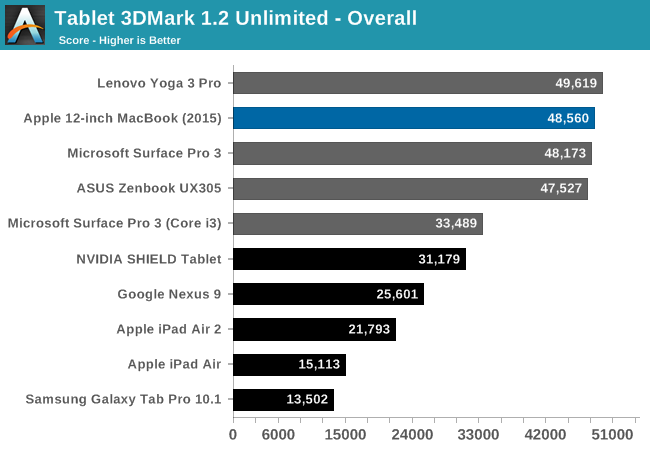
While the iPad Air 2 makes a good run on the MacBook in the web benchmarks, it and the other tablets are even more power limited than the MacBook, and as a result their GPU performance is even more constrained. The MacBook still has a better than 2x lead on the iPad Air 2 in this GPU benchmark, so judging from this it will be some time yet until an iPad's GPU performance catches up with this MacBook's.










354 Comments
View All Comments
darwinosx - Tuesday, April 14, 2015 - link
If you recall back then $400 was cheap. Now you can buy a cheap Acer etc. Windows laptop for around that. But the are junk.Impulses - Tuesday, April 14, 2015 - link
$400 was cheap then? Because inflation goes in reverse? :p I don't know if you can say $400 was a small sum, I guess in relative terms you could argue most laptops were over $600... That seems like splitting hairs tho, a year or two later C2D laptops were encroaching on netbook prices and ultrabooks started looming in an effort to bring premium systems and prices into the limelight.barleyguy - Tuesday, April 21, 2015 - link
In computers, yes inflation goes in reverse. Computers have gotten more powerful and less expensive over time. The original 8086 IBM PC was $7000.MykeM - Tuesday, April 14, 2015 - link
The x7 in the Surface 3 is nowhere as powerful as the Core-M. It's even less powerful than the A8X despite having one extra core (and even less than the A8 in single core Geekbench 3 score):A8X (3 cores): 1808/4529 (single/multi)
x7-Z8700 (4 cores): 1024/3445
Core M-5Y31 (2 Cores): 2446/4615
kyuu - Tuesday, April 14, 2015 - link
FFS, please stop quoting Geekbench like it's a reliable benchmark.68k - Wednesday, April 15, 2015 - link
Amen to that!Geekbench score has some merit when comparing the same family of CPUs, like comparing one big-core Intel vs another big-core Intel. Comparing Geekbench result from different ISA seem to make little sense as the relative score is often quite far from what one see when comparing "real" programs.
Gogogoran - Wednesday, April 15, 2015 - link
I bought an eeepc 1000he as a more mobile laptop since my 15.4" at the time was becoming a pain with its lackluster battery life of 2.5 hours real life, 3.5 if I tried. I have been meaning to upgrade to a SSD and 2GB ram but I feel that would still be limiting with the low resolution screen and single core atom. Still works great after over 5 years.I'd argue that the true functional successor is the Transformer T100 and other OEM equivalents. Its cost is also on par with the original Asus eeepcs and is far more functional, even taking into account the time frame. The surface 3 I would call a premium netbook. I'm kinda more interested to see asus's transformers with the x7 when they come out. I was admittedly disappointed when the new chi line came out with the same internals as the T100 and at the top end core M. Ah well. I have a yoga pro 2 and I'm content with just about everything as my sole mobile PC now and I'm glad to not be shifting between two laptops anymore.
darwinosx - Tuesday, April 14, 2015 - link
Calling this a netbook is the easiest, laziest, and most ignorant response to make. Typically by people who have some whiny anti-apple issue.Netbooks were cheap laptops with substandard everything. Now there are even cheaper laptops with lousy displays, build quality and of course they run Windows.
PEJUman - Tuesday, April 14, 2015 - link
No Netbook from functionality standpoint is an ultra efficient, relatively low performance, severely limited IO compromise to the 2012 laptop market. From that functionality standpoint, this macbook is a netbook.Core M is still slow according to 2015 standards, the macbook still only have a single USB port. Both of this makes it a 2015 netbook, albeit a premium one, around $800ish gets you the nicer material and screen, but not functionality.
I still can't do reasonable FPS on 4K encodes with it, it still will not run my USB to CAN bus adapter. I still need a hub to run multiple USB devices, etc. The same relative feature and performance compromises between laptop-netbook still here. Both devices evolved (and our expectation should as well), in the past 3 years since netbook term was coined.
ppi - Tuesday, April 14, 2015 - link
First netbooks arrived like 8-9 years ago. iPad & tablets completely annihilated that category. Any el cheapo Android tablet can do more than Vista-powered Atom with 1GB RAM and mechanical HDD paired with 1024x800 TN panel.MacBook Core-M performance is absolutely perfect for anyone doing mostly e-mails, office, browsing. Short, burst, tasks. Doubtful you would be able to tell difference at these tasks between Core-M and i7-4790.
Obvisously, the 4.5W power envelope has its downsides - most demanding game this could reasonably run is probably something like plants vs zombies. But then you would get rewarded by great portability when running around airports.
If your performance yardstick is video encoding, anything short of full desktop is unsatisfactory anyway.